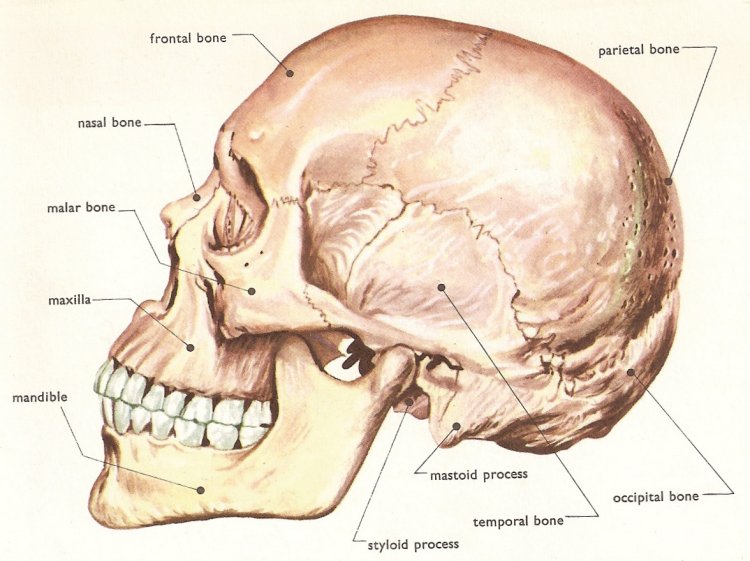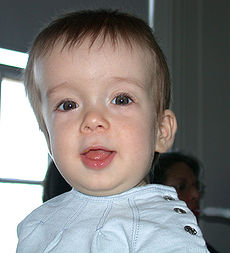Skull.

The skull is the bony casing of the head of humans and other vertebrates. The mammalian skull consists primarily of the cranium (the protective casing of the brain) and the bones of the face, which include the maxilla(upper jaw bone), mandible (lower jaw bone), zygomatic bones (cheekbones), and the nasal bones. Closely associated with, but not strictly part of, the skull are the hyoid (a small bone at the back of the tongue) and the auditory ossicles (three tiny bones in each middle ear).
A normal adult human skull has 8 bones in the cranium and 14 in the face. This makes a total of 29 if the 6 auditory ossicles and one hyoid are also included. None of these bones are moveable except for the jointbetween the lower jaw and the rest of the skull. The foramen magnum is a large opening at the base of the skull through which the spinal cord passes from the brain.
A human skull is almost full sized at birth. However the 8 bones that make up the cranium are not yet fused together. This means that the skull can flex and deform during birth, making it easier to deliver a baby through the narrow birth canal. The individual plates of bone fuse together after about 24 months to form the adult skull.

Detailed anatomy
The eight bones of the cranium are the occipital, two parietal,frontal, two temporal, spheroid, and ethmoid bones. The 14 bones of the face, which surround the cavities of the mouth and nose and complete the orbits or cavities for the eyes, are the two nasal, two superior maxillary, two lachrymal, two zygomatic (malar), two palate, two inferior turbinated, vomer, and inferior maxillary.
Sutures
The lower jaw articulates with the temporal bones by means of a diarthrodial joint, but all the others are joined bysutures. On the base of the cranium the occipital and sphenoid bones articulate by means of a plate of cartilage(synchrondrosis) in infants and children. In adults this becomes a bony union. Sutures are named for the bones between which they are found, but those around the parietal bones are given special names – for example, inter-parietal or sagittal; occipito-parietal or lambdoid; fronto-parietal or coronal; parietal-temporal or squamous. During adult life many of the sutures close by bony union and disappear, but both the age at which this occurs and the order of occurrence are subject to variation.
Wormian bones are irregular ossifications found in relation to the sutures of cranial bones, but seldom seen in relation to the bones of the face. They are most frequent in relation to the lambdoid suture, and seldom one inch (2.5 cm) in diameter. The closure of a suture stops the growth of the skull along that line, and in order to compensate for this defect an increase of growth may occur at right angles to the closed suture and thus irregularities of form may result: for example, closure of the sagittal suture stops transverse growth, but the skull continues to grow in the longitudinal and vertical directions, with the result that a boat-shaped cranium is produced – scaphocephaly.
Foramina
The bones of the skull are pierced by holes (foramina), and similar holes are found in relation to the adjacent margins of bones. Most of these foramina are situated in the base or floor of the skull, and are for the ingress ofarteries and the exit of veins and cranial nerves. The largest of these foramina – the foramina magnum – is found in the occipital bone. It is situated immediately above the ring of the first cervical vertebra (the atlas), and through it the continuity between the brain and the spinal cord is established, and further, it transmits the vertebral arteries which supply blood to the brain.
Sinuses
Several of the skull bones, notably the maxillae, sphenoid bone, frontal bone, and ethmoid bone, contain sinuses(air-filled spaces); these sinuses are called the paranasal sinuses. In addition, there are sapces in the temporal bones that house the structures of the middle and inner ear.
Human skull compared with that other animals
Compared with the skulls of other animals, the form of the human skull is modified by the proportionately large size of the brain and consequent expansion of the the bones that surround it; by the small size of the face, especially of the jaws, so that the human face, instead of projecting in front of, is under the forepart of the cranium; by the erect attitude, which places the base of the skull at a considerable angle with the vertebral column, and, in consequence of a development backwards from the point of articulation with the vertebrae, the skull is nearly balanced on the summit of the vertebral column. Hence the orbits look forward and the nostrils look downward.
Craniosynostosis.

Craniosynostosis is a birth defect that causes one or more sutures on a baby's head to close earlier than normal.
The skull of an infant or young child is made up of bony plates that allow for growth of the skull. The borders at which these plates intersect are called sutures or suture lines. The sutures between these bony plates normally close by the time the child is 2 or 3 years old.
Early closing of a suture causes the baby to have an abnormally shaped head.
Causes.
The cause of craniosynostosis is unknown. Genes may play a role. However, there is usually no family history of the condition.
A form passed down through families (heredited) can occur with other health problems, such as seizures, decreased intelligence, and blindness. Genetic disorders commonly linked to craniosynostosis include Crouzon, Apert, Carpenter, Chotzen, and Pfeiffer syndromes.
However, most children with craniosynostosis are otherwise healthy and have normal intelligence.
Symptoms.
Symptoms depend on the type of craniosynostosis. They may include:
- No "soft spot" (fontanelle) on the newborn's skull
- A raised hard ridge along the affected sutures
- Unusual head shape
- Slow or no increase in the head size over time as the baby grows
Types of craniosynostosis:
- Sagittal synostosis (scaphocephaly) is the most common type. It affects the main suture on the very top of the head. The early closing forces the head to grow long and narrow, instead of wide. Babies with this type tend to have a broad forehead. It is more common in boys than girls.
- Frontal plagiocephaly is the next most common type. It affects the suture that runs from ear to ear on the top of the head. It is more common in girls.
- Metopic synostosis is a rare form that affects the suture close to the forehead. The child's head shape may be described as trigonocephaly. It may range from mild to severe.
Treatment.
Surgery is done while the baby is still an infant. The goals of surgery are:
- Relieve any pressure on the brain
- Make sure there is enough room in the skull to allow the brain to properly grow
- Improve the appearance of the child's head
Spina bifida.

Spina bifida is the most common disabling birth defect in the United States. It is a type of neural tube defect, which is a problem with the spinal cord or its coverings. It happens if the fetal spinal column doesn't close completely during the first month of pregnancy. There is usually nerve damage that causes at least some paralysis of the legs. Many people with spina bifida will need assistive devices such as braces, crutches or wheelchairs. They may have learning difficulties, urinary and bowel problems or hydrocephalus, a buildup of fluid in the brain.
There is no cure. Treatments focus on the complications, and can include surgery, medicine and physiotherapy. Taking folic acid can reduce the risk of having a baby with spina bifida. It's in most multivitamins. Women who could become pregnant should take it daily
No hay comentarios:
Publicar un comentario